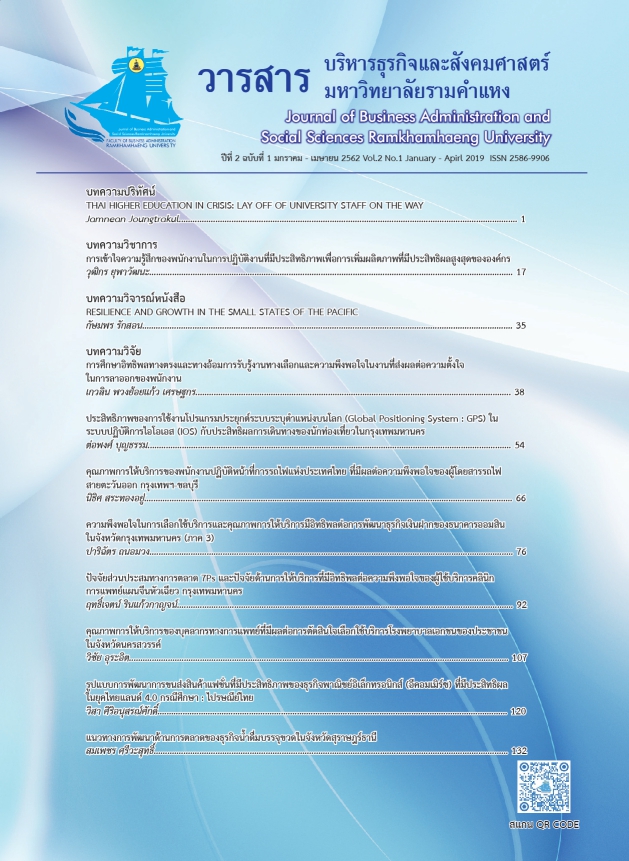THE EFFICIENCY OF FASHION TRANSPORTATION DEVELOPMENT OF EFFECTIVENESS ELECTRONICS COMMERCE BUSINESS IN 4.0 AGE IN A CASE STUDY OF THAILAND POST
Main Article Content
Abstract
The purpose of this research was to study the efficiency of fashion transportation development of effectiveness electronics commerce business in 4.0 Age in a case study of Thailand Post. A convenience sample of 400 people was administered a closed-ended questionnaire survey, with a reliability of .97 and its content validity being approved by specialists. The data were analyzed by percentage, mean, standard deviation and multiple regression analysis. It was found that the people who use the Thailand Post transportation service for fashion in e-commerce business were mostly female with an age range of 31-40 years, possess a bachelor’s degree and are single. They are mostly employees of a private company with an average income per month of 10,001-20,000 Bahts. The most popular purchased product is clothing which has been delivered by the Thailand Post service between 1-5 times. They had a high opinion about using transportation for fashion in the e-commerce business via Thailand Post. The hypothesis test found that the model of fashion transportation in the e-commerce business via Thailand Post had a positive effect on the efficiency delivery and the delivery performance which had a positive effect on the efficiency delivery. The efficiency delivery also had a positive effect on the effectiveness delivery.
Article Details
เนื้อหาและข้อมูลในบทความที่ลงตีพิมพ์ในวารสารบริหารธุรกิจและสังคมศาสตร์ มหาวิทยาลัยรามคำแหง ถือเป็นข้อคิดเห็นและความรับผิดชอบของผู้เขียนบทความโดยตรง ซึ่งกองบรรณาธิการไม่จำเป็นต้องเห็นด้วย หรือร่วมรับผิดชอบใดๆ
บทความ ข้อมูล เนื้อหา รูปภาพ ฯลฯ ที่ได้รับการตีพิมพ์ในวารสารบริหารธุรกิจและสังคมศาสตร์ มหาวิทยาลัยรามคำแหง ถือเป็นลิขสิทธิ์ของวารสารบริหารธุรกิจและสังคมศาสตร์ มหาวิทยาลัยรามคำแหง หากบุคคลหรือหน่วยงานใดต้องการนำบทความทั้งหมดหรือส่วนหนึ่งส่วนใดไปเผยแพร่ต่อ หรือเพื่อกระทำการใดๆ จะต้องได้รับอนุญาตเป็นลายลักษณ์อักษรจากวารสารบริหารธุรกิจและสังคมศาสตร์ มหาวิทยาลัยรามคำแหง ก่อนเท่านั้น
References
เพ็ญพิชชา พงษ์ปรีดา. (2556). กรณีศึกษาการเพิ่มประสิทธิภาพการขนส่งวัตถุอากาศยาน บริษัทการบินไทย จำกัด (มหาชน) ฝ่ายการพาณิชย์สินค้าและไปรษณียภัณฑ์อาคารคลังสินค้า ท่าอากาศยานสุวรรณภูมิ, สาขาวิชาเทคโนโลยีโลจิสติกส์ คณะวิศวกรรมศาสตร์ มหาวิทยาลัยเทคโนโลยีโลจิสติกส์.
ทิรัศม์ชญา พิพัฒน์เพ็ญ และคณะ. (2557). รายงานการวิจัยเรื่อง การประเมินประสิทธิภาพและประสิทธิผล การปฏิบัติราชการของเทศบาลนครสงขลา, มหาวิทยาลัยหาดใหญ่, 16-22
นิเวศน์ ธรรมชัยชูศักดิ์. (2559). ประสิทธิผลของการพัฒนาขีดความสามารถทางด้านระบบความปลอดภัยในการขนส่งสินค้าอันตรายของประเทศไทย. วารสารการพัฒนาชุมชนและคุณภาพชีวิต, 4(1), 47-62.
ศูนย์วิจัยกสิกรไทย. (2560). บรรจุภัณฑ์เพื่อการขนส่งรับอานิสงส์ E-Commerce รุ่ง สร้างมูลค่าตลาด 5,600 ล้านบาทในปี 2560. สืบค้นเมื่อ 13 ตุลาคม 2560, จาก http://www.newsdatatoday.com//images/News/OO1-9-17/579.pdf.
Andrejić, M., Bojović, N., & Kilibarda, M. (2016). A framework for measuring transport efficiency in distribution centers. Transport Policy, 45(C), 99-106.
Bhattacharyya, K., & Guiffrida, A. L. (2015). An optimization framework for improving supplier delivery performance. Applied Mathematical Modelling, 39(13), 3771-3783.
Bushuev, M. A. (2017). Delivery performance improvement in two-stage supply chain. International Journal of Production Economics, 195(1), 66-73.
Lemke, J., Iwan, S., & Korczak, J. (2016). Usability of the Parcel Lockers from the Customer Perspective–The Research in Polish Cities. Transportation Research Procedia, 16(C), 272-287.
Nakandala, D., Samaranayake, P., & Lau, H. C. W. (2013). A fuzzy-based decision support model for monitoring on-time delivery performance: A textile industry case study. European Journal of Operational Research, 225(3), 507-517.
Qu, T. , Mao, T., & Zhou, X. (2017). "Research about the Development Path of “Internet + Logistics” under E-commerce" (2017), WHICEB 2017 Proceedings, 38.


